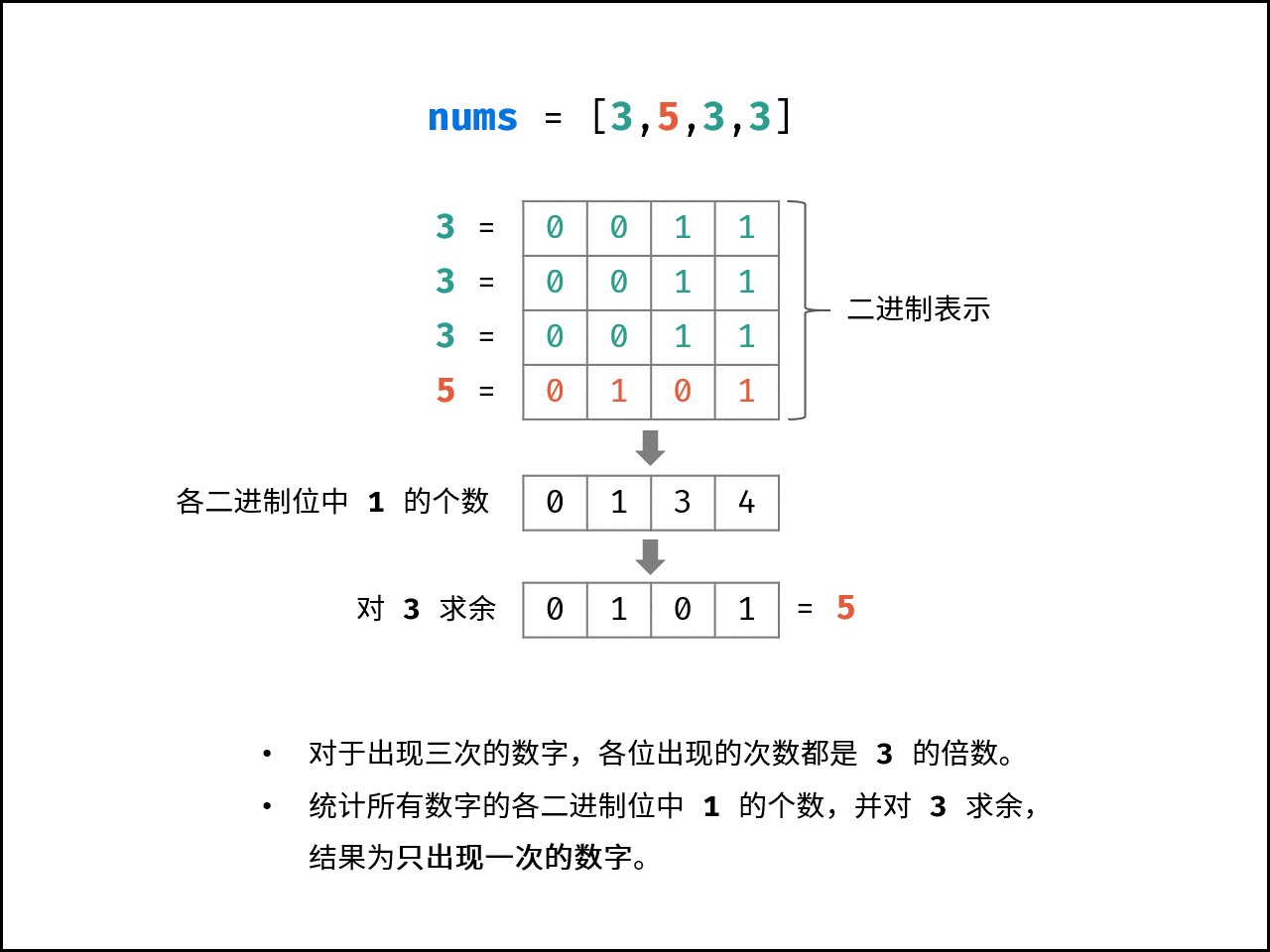解题思路:
如下图所示,考虑数字的二进制形式,对于出现三次的数字,各 二进制位 出现的次数都是 $3$ 的倍数。 因此,统计所有数字的各二进制位中 $1$ 的出现次数,并对 $3$ 求余,结果则为只出现一次的数字。
下图中的
nums对应本题的actions。

方法一:有限状态自动机
各二进制位的 位运算规则相同 ,因此只需考虑一位即可。如下图所示,对于所有数字中的某二进制位 $1$ 的个数,存在 3 种状态,即对 3 余数为 $0, 1, 2$ 。
- 若输入二进制位 $1$ ,则状态按照以下顺序转换;
- 若输入二进制位 $0$ ,则状态不变。
$$ 0 \rightarrow 1 \rightarrow 2 \rightarrow 0 \rightarrow \cdots $$

如下图所示,由于二进制只能表示 $0, 1$ ,因此需要使用两个二进制位来表示 $3$ 个状态。设此两位分别为 $two$ , $one$ ,则状态转换变为:
$$ 00 \rightarrow 01 \rightarrow 10 \rightarrow 00 \rightarrow \cdots $$

接下来,需要通过 状态转换表 导出 状态转换的计算公式 。首先回忆一下位运算特点,对于任意二进制位 $x$ ,有:
- 异或运算:
x ^ 0 = x ,x ^ 1 = ~x - 与运算:
x & 0 = 0,x & 1 = x
计算 $one$ 方法:
设当前状态为 $two$ $one$ ,此时输入二进制位 $n$ 。如下图所示,通过对状态表的情况拆分,可推出 $one$ 的计算方法为:
if two == 0:
if n == 0:
one = one
if n == 1:
one = ~one
if two == 1:
one = 0引入 异或运算 ,可将以上拆分简化为:
if two == 0:
one = one ^ n
if two == 1:
one = 0引入 与运算 ,可继续简化为:
one = one ^ n & ~two
计算 $two$ 方法:
由于是先计算 $one$ ,因此应在新 $one$ 的基础上计算 $two$ 。 如下图所示,修改为新 $one$ 后,得到了新的状态图。观察发现,可以使用同样的方法计算 $two$ ,即:
two = two ^ n & ~one
返回值:
以上是对数字的二进制中 “一位” 的分析,而 int 类型的其他 31 位具有相同的运算规则,因此可将以上公式直接套用在 32 位数上。
遍历完所有数字后,各二进制位都处于状态 $00$ 和状态 $01$ (取决于 “只出现一次的数字” 的各二进制位是 $1$ 还是 $0$ ),而此两状态是由 $one$ 来记录的(此两状态下 $twos$ 恒为 $0$ ),因此返回 $ones$ 即可。
< ,
, ,
, ,
, ,
, ,
, >
>
代码:
class Solution:
def trainingPlan(self, actions: List[int]) -> int:
ones, twos = 0, 0
for action in actions:
ones = ones ^ action & ~twos
twos = twos ^ action & ~ones
return onesclass Solution {
public int trainingPlan(int[] actions) {
int ones = 0, twos = 0;
for(int action : actions){
ones = ones ^ action & ~twos;
twos = twos ^ action & ~ones;
}
return ones;
}
}class Solution {
public:
int trainingPlan(vector<int>& actions) {
int ones = 0, twos = 0;
for(int action : actions){
ones = ones ^ action & ~twos;
twos = twos ^ action & ~ones;
}
return ones;
}
};复杂度分析:
- 时间复杂度 $O(N)$ : 其中 $N$ 位数组 $actions$ 的长度;遍历数组占用 $O(N)$ ,每轮中的常数个位运算操作占用 $O(32 \times3 \times 2) = O(1)$ 。
- 空间复杂度 $O(1)$ : 变量 $ones$ , $twos$ 使用常数大小的额外空间。
方法二:遍历统计
此方法相对容易理解,但效率较低,总体推荐方法一。
使用 与运算 ,可获取二进制数字 $action$ 的最右一位 $n_1$ :
$$ n_1 = action & i $$
配合 右移操作 ,可从低位至高位,获取 $action$ 所有位的值(设 int 类型从低至高的位数为第 0 位 至第 31 位,即 $n_0$ ~ $n_{31}$ ):
$$ action = action >> 1 $$
建立一个长度为 32 的数组 $counts$ ,通过以上方法可记录所有数字的各二进制位的 $1$ 的出现次数之和。
counts = [0] * 32
for action in actions:
for i in range(32):
counts[i] += action & 1 # 更新第 i 位 1 的个数之和
action >>= 1 # 第 i 位 --> 第 i + 1 位int[] counts = new int[32];
for(int action : actions) {
for(int i = 0; i < 32; i++) {
counts[i] += action & 1; // 更新第 i 位 1 的个数之和
action >>= 1; // 第 i 位 --> 第 i + 1 位
}
}int counts[32] = {0}; // C++ 初始化数组需要写明初始值 0
for(int action : actions) {
for(int i = 0; i < 32; i++) {
counts[i] += action & 1; // 更新第 i 位 1 的个数之和
action >>= 1; // 第 i 位 --> 第 i + 1 位
}
}将 $counts$ 各元素对 $3$ 求余,则结果为 “只出现一次的数字” 的各二进制位。
for i in range(31, -1, -1):
x = counts[i] %= 3 # 得到 “只出现一次的数字” 的第 i 位for(int i = 31; i >= 0; i--) {
int x = counts[i] %= 3; // 得到 “只出现一次的数字” 的第 i 位
}for(int i = 31; i >= 0; i--) {
int x = counts[i] % 3; // 得到 “只出现一次的数字” 的第 i 位
}利用 左移操作 和 或运算 ,可将 $counts$ 数组中各二进位的值恢复到数字 $res$ 上。
for i in range(31, -1, -1):
res <<= 1
res |= counts[i] % 3 # 恢复第 i 位for(int i = 31; i >= 0; i--) {
res <<= 1;
res |= counts[i] % 3; // 恢复第 i 位
}for(int i = 31; i >= 0; i--) {
res <<= 1;
res |= counts[i] % 3; // 恢复第 i 位
}最终返回 $res$ 即可。
由于 Python 的存储负数的特殊性,需要先将 $0$ - $31$ 位取反(即
res ^ 0xffffffff),再将所有位取反(即~)。 此组合操作含义: 将数字 $31$ 以上位取反,$0$ - $31$ 位不变。
代码:
实际上,只需要修改求余数值 $m$ ,即可实现解决 除了一个数字以外,其余数字都出现 $m$ 次 的通用问题。
设 int 类型从低至高的位数为第 0 位 至第 31 位。
class Solution:
def trainingPlan(self, actions: List[int]) -> int:
counts = [0] * 32
for action in actions:
for i in range(32):
counts[i] += action & 1 # 更新第 i 位 1 的个数之和
action >>= 1 # 第 i 位 --> 第 i 位
res, m = 0, 3
for i in range(31, -1, -1):
res <<= 1
res |= counts[i] % m # 恢复第 i 位
return res if counts[31] % m == 0 else ~(res ^ 0xffffffff)class Solution {
public int trainingPlan(int[] actions) {
int[] counts = new int[32];
for(int action : actions) {
for(int i = 0; i < 32; i++) {
counts[i] += action & 1; // 更新第 i 位 1 的个数之和
action >>= 1; // 第 i 位 --> 第 i 位
}
}
int res = 0, m = 3;
for(int i = 31; i >= 0; i--) {
res <<= 1;
res |= counts[i] % m; // 恢复第 i 位
}
return res;
}
}class Solution {
public:
int trainingPlan(vector<int>& actions) {
int counts[32] = {0}; // C++ 初始化数组需要写明初始值 0
for(int action : actions) {
for(int i = 0; i < 32; i++) {
counts[i] += action & 1; // 更新第 i 位 1 的个数之和
action >>= 1; // 第 i 位 --> 第 i 位
}
}
int res = 0, m = 3;
for(int i = 31; i >= 0; i--) {
res <<= 1;
res |= counts[i] % m; // 恢复第 i 位
}
return res;
}
};复杂度分析:
- 时间复杂度 $O(N)$ : 其中 $N$ 位数组 $actions$ 的长度;遍历数组占用 $O(N)$ ,每轮中的常数个位运算操作占用 $O(1)$ 。
- 空间复杂度 $O(1)$ : 数组 $counts$ 长度恒为 $32$ ,占用常数大小的额外空间。